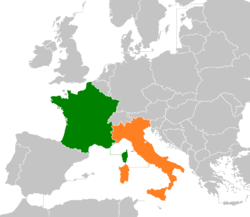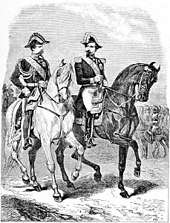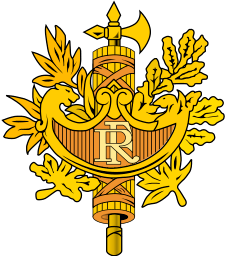France–Italy relations
 | |
France |
Italy |
|---|---|
France–Italy relations refer to the interstate relations as well as the historical links between the French Republic and the Italian Republic (since 1946) and its predecessor the Kingdom of Italy (1861—1946). Both countries were among the Inner six that founded the European Community, the predecessor of the EU. They are also founding members of the G7/G8 and NATO. Since April 9, 1956 Rome and Paris are exclusively and reciprocally twinned with each other, with the popular saying:
Border
The two countries share 488 km of border[3] The border is mostly that determined in 1860 in the Treaty of Turin with minor rectifications acted during the Treaty of Paris. The kingdom of France had shared a border with the Duchy of Savoy since the incorporation of Provence into France under Charles VIII in 1486. The wider French-Italian border region had been part of the Kingdom of Arelat during the 11th to 14th centuries.
The border between the France and Savoy had remained in flux since the Italian Wars. In the early modern period, it was fixed in the Treaty of Turin of 1696. After the War of the Spanish Succession, the House of Savoy made large territorial gains, becoming the 18th-century nucleus for the later Italian unification. Savoy was occupied by revolutionary France from 1792 to 1815. Savoy, along with Piedmont and Nice, was conjoined into the Kingdom of Sardinia at the Congress of Vienna in 1815,[4] In 1860, under the terms of the Treaty of Turin, Savoie and Nice was annexed by France, while Lombardy passed to Italy. The last Duke of Savoy, Victor Emmanuel II, became King of Italy.
The border between the two countries does not match the linguistic border. Corsica, while traditionally Italian-speaking, is part of France, whereas the Valle d'Aosta, while traditionally French-speaking, is part of Italy.
There remains a territorial dispute over the ownership of the Mont Blanc summit, the highest mountain in Western Europe.
Economy
France is Italy's second-largest trading partner and, symmetrically, Italy is also the second-largest trading partner of France.[5]
Intercultural influences
Italian culture in France
Italian Renaissance had a great influence on France during the 16th century.
Two queens of France, Caterina de Medici and Maria de Medici, and a chief minister of France, Giulio Mazzarino, were Italians.
The House of Bonaparte traces its roots in Italy, precisely in San Miniato, located in the region of Tuscany.
Many Italian artists of the 19th and 20th century (Giuseppe De Nittis, Boldini, Gino Severini, Amedeo Modigliani, Giorgio de Chirico) went to France to work, at a time when Paris was the international capital of arts.
Many Italian immigrated to France during the first part of the 20th century: in 1911, 36% of foreigners living in France were Italian.[6] Immigrants have sometime suffered a violent anti-Italianism like the Vêpres marseillaises (Marseilles vespers) in June 1881 or Aigues-Mortes massacre on 17 August 1893.[7] Today, it is estimated that as many as 5 million French nationals have Italian ancestry going back three generations.[8]
Nowadays 340,000 Italian nationals live in France,[9] while 130,000 French citizens live in Italy. In the French Departement of Alpes-Maritimes at least 80% of the population can trace some ancestry back to Italy and 40% can claim it as solely Italian and Italian is the mother language of 30% of the population.
French culture in Italy
The Norman and the Angevin dynasties that ruled the Kingdom of Sicily and the Kingdom of Naples during the Middle Ages came from France. The Normans introduced a distinct romanesque art and castle architecture imported from Northern France. At the end of the 13th century, the Angevin introduced gothic art in Naples, giving birth to a peculiar gothic architecture style inspired by Southern French gothic.
Provençal writers and troubadours of the 12th and 13th century had an importance influence on the Dolce Stil Novo movement and on Dante Alighieri.
The Savoy dynasty that ruled Piedmont then unified Italy during the Risorgimento is of French origin (from the historical region of Savoy).
The Aosta Valley region in northwest Italy is culturally French and the French language is recognised as an official language there.
During the 17th and 18th century many French artists lived and worked in Italy, especially in Rome, which was the international capital of arts. These include Simon Vouet, Valentin de Boulogne, Nicolas Poussin, Claude Lorrain and Pierre Subleyras.
The Villa Medici in Rome hosts the French Academy in Rome. The Academy was founded in 1666 by Louis XIV to train French artists (painters, sculptors, architects) and make them familiar with Roman and Italian Renaissance art. Today the Academy is responsible for promoting French culture in Italy.
From 1734 to 1861, the Kingdom of Naples and of Sicily were under the domination of the Spanish branch of the Bourbon dynasty, originating from France. Charles III, king of Naples was the grand son of Louis, Dauphin de France, son of Louis XIV.
During the Napoleonic era, large parts of Italy were under French control and some were annexed to the First French Empire. The Kingdom of Naples was ruled by Joseph Bonaparte, brother of Napoleon Bonaparte, and then by Marshall Joachim Murat : it was under Joseph Bonaparte's rule that feudalism was abolished, in 1806.
Institutions
Both France and Italy are founder members of the European Union and adopted the euro from its introduction.
Since 1982, an annual summit has formalised French-Italian cooperation. The first was held in Villa Madama.[10]
Military
The Prime minister of the Kingdom of Sardinia Camillo Benso was able to take Napoleon III on his side after the Orsini affair during the Italian Unification: The French army was allied with Victor Emmanuel II of Italy during the Second Italian War of Independence and defeated the Austrians at the Battle of Magenta and the Battle of Solferino. After that, France opposed Italy during the Capture of Rome (but did not do anything to prevent it), that represented the end of the Papal temporal power.
After World War I the governments of the two countries were both among the big four that defeated the Central Powers.
The last military conflict was the Italian invasion of France in June 1940.
Sport
- France-Italy football rivalry is one of the most famous sport rivalries worldwide.
- The Giuseppe Garibaldi Trophy is a trophy for the winner of the Six Nations match between France and Italy in rugby union.
See also
- Hôtel de Boisgelin : Italian embassy in France
- Palazzo Farnese : French embassy in Italy.
Notes and references
- ↑ "Twinning with Rome". Archived from the original on 25 May 2017. Retrieved 27 May 2010.
- ↑ "Les pactes d'amitié et de coopération". Mairie de Paris. Archived from the original on 11 October 2007. Retrieved 14 October 2007.
- ↑ https://www.cia.gov/library/publications/the-world-factbook/fields/2096.html
- ↑ Wells, H. G., Raymond Postgate, and G. P. Wells. The Outline of History, Being a Plain History of Life and Mankind. Garden City, NY: Doubleday, 1956. p. 723–753.
- ↑ http://www.diplomatie.gouv.fr/en/country-files/italy/france-and-italy/economic-relations-6993/
- ↑ Corti, Paola (2003), L'emigrazione italiana in Francia: un fenomeno di lunga durata, Altreitalie, no. 26, janvier-juin 2003
- ↑ L'immigration italienne en Provence au XIXe siècle
- ↑ Cohen, Robin (1995). Cambridge Survey. Books.google.com. ISBN 978-0-521-44405-7. Retrieved 2009-05-11.
- ↑ http://www.insee.fr/fr/themes/document.asp?ref_id=ip1098®_id=0&page=graph#graphique1
- ↑ http://www.diplomatie.gouv.fr/en/country-files/italy/france-and-italy/political-relations-6992/
.jpg)


